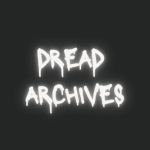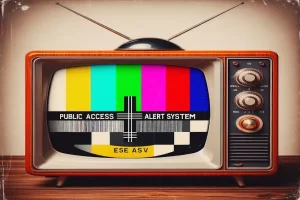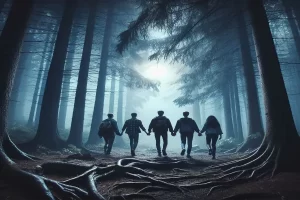Local 58 stands as one of the pioneering forces in the analogue horror genre, cementing its place as a key series that shaped the direction of this unsettling, internet-driven subgenre. Launched in 2017 by creator Kris Straub, Local 58 quickly gained attention for its chilling atmosphere, retro aesthetics, and innovative storytelling, making it a blueprint for many of the analogue horror projects that followed. By blending the eerie aesthetics of old television broadcasts, distorted visuals, and ominous audio, Local 58 pushed the boundaries of horror in ways that few other series had done before.
The significance of Local 58 extends beyond its immediate success. It set the stage for future creators to experiment with the notion of “lost” or “hijacked” media, using outdated technology as both a storytelling tool and a source of terror. As one of the earliest examples of the genre, it laid the foundation for the unique blend of nostalgia and fear that defines analogue horror.
In this deep dive, we’ll explore why Local 58 is considered the blueprint for analogue horror. We’ll look into its key elements, such as its use of VHS-style visuals, public access television aesthetics, and the unsettling narratives crafted through lost broadcasts. We’ll also examine the series’ lasting impact and how it influenced the genre’s evolution into what it is today.
What Is Local 58?
Series Overview
Local 58 is a web-based analogue horror series created by Kris Straub that immerses viewers in a fictional world centered around a small, local TV station. The premise of the series is rooted in the eerie and unsettling, as the station is plagued by strange and disturbing broadcasts. These broadcasts, which seem to interrupt regular programming, feature ominous transmissions, cryptic messages, and surreal content that evokes a sense of creeping dread. The series capitalizes on the discomforting nature of “hijacked” media, tapping into the fear of something being wrong with the everyday—like your own TV station being invaded by unnatural forces.
The narrative in Local 58 revolves around the strange occurrences that happen on the station’s broadcast channels, with each transmission carrying an increasingly sinister tone. The unsettling nature of these broadcasts, such as public service announcements, emergency alerts, or even children’s programming gone horribly wrong, builds a world where something sinister lurks just beneath the surface of everyday life.
The Structure of Local 58
Local 58 is designed as an episodic series, with each episode acting as a standalone broadcast that unveils a different, horrifying scenario. These episodes vary in form, from seemingly innocuous TV segments to full-fledged panic-inducing events. Each installment typically follows a “found footage” format, with the idea being that these broadcasts were somehow uncovered or lost, offering a chilling glimpse into an alternate reality or timeline.
The structure of the series plays a significant role in its effectiveness, as it mirrors the experience of watching actual discovered footage. The interruptions in the normal flow of broadcast, the grainy, low-resolution visuals, and the eerie, cryptic audio contribute to the feeling of authenticity. Viewers are led to feel as though they are witnessing something they shouldn’t—something hidden or forgotten—that now serves as a haunting window into a terrifying world. This episodic, “real” feel is central to the success of Local 58 in evoking fear, making it not just a series to watch, but a chilling experience to be immersed in.
The Aesthetic of Local 58: Analogue Technology as Horror
VHS-Style Visuals and Audio
Local 58 masterfully utilizes VHS-style visuals, static, and distortion to enhance its unsettling atmosphere, immersing the viewer in a world where the technology itself becomes part of the horror. The grainy visuals, flickering screens, and distorted images create a visual style that’s immediately reminiscent of old home videos or forgotten tapes, evoking a sense of nostalgia mixed with discomfort. These visuals not only set the tone for the series but also heighten the eerie feeling that something is wrong, creating a palpable sense of unease throughout each episode.
The use of distorted audio, low-fidelity sound, and glitch effects plays an equally important role in reinforcing the analogue aesthetic. Audio interruptions such as hissing static, garbled voices, or sudden bursts of distortion further pull the viewer into this disjointed, chaotic world. These sonic irregularities mimic the malfunctioning of older devices—think of a TV set losing its signal or the sound of a tape being eaten by a VCR—which taps into a primal discomfort. The unsettling blend of warped audio and low-quality visuals reinforces the idea that these broadcasts were never meant to be seen or heard, enhancing the sense of fear that something otherworldly is creeping through the static.
Imperfections and Their Role in the Fear Factor
The imperfections inherent in analogue media—such as the grainy visuals, audio interference, and occasional glitches—play a crucial role in establishing Local 58‘s sense of dread. These flaws, which were once seen as limitations of older technology, are now a key element in crafting the horror. The grain and distortion make the viewer feel like they are witnessing something forbidden or lost in time. Rather than offering clarity, these imperfections obscure the truth, leaving much to the imagination. This technique builds an atmosphere of ambiguity and suspicion, where the viewer is constantly questioning what they are seeing and hearing.
On a psychological level, the flaws in the analogue format contribute to the viewer’s sense of unease by creating a feeling that they are watching something that shouldn’t exist—or worse, something that has been intentionally hidden away. The static, distortion, and visual glitches make the horror feel more authentic, as if these broadcasts were never meant to be discovered by the public. This taps into a fear of the unknown and the idea of forgotten or censored content being unearthed, which heightens the terror in Local 58. The imperfections of analogue technology don’t just set the stage for the horror—they become part of it, making the experience even more immersive and unsettling.
Themes and Storytelling in Local 58
The Concept of Paranoia and Control
Local 58 taps into the deep, unsettling themes of paranoia and the loss of control, with its broadcasts presenting increasingly bizarre and cryptic content that distorts reality. Each transmission seems to come from a world slightly off-kilter, where the boundaries of truth and fiction blur. The station’s broadcasts don’t just serve as horror scenes—they become a tool of manipulation, subtly guiding the viewer’s perception of reality. In this world, the television station isn’t merely transmitting signals; it seems to have control over the very fabric of the viewer’s reality.
This theme is explored through episodes where the seemingly innocuous nature of local TV programming is twisted into something far more sinister. The idea that a trusted medium of communication could distort the truth, planting seeds of doubt and fear, resonates with audiences. The broadcasts evoke the feeling that viewers are being manipulated, shown only what the station allows them to see, feeding into a creeping paranoia. The concept of control is a central pillar in Local 58, as the station appears to craft a narrative that isn’t just for entertainment—it’s a narrative that controls perception, creates fear, and makes people question what is real.
The Fear of the Unknown and the Unseen
One of the most effective tools Local 58 uses to evoke terror is the fear of the unknown and the unseen. The series masterfully builds a sense of unease through its ambiguity, leaving much of its narrative unexplained. There are no easy answers, and the mysteries presented by the broadcasts are often left unresolved, intensifying the viewer’s sense of discomfort. The unknown is one of horror’s most primal fears, and Local 58 leverages this by showing strange and terrifying events without providing concrete explanations. What viewers see in the broadcasts might hint at something far worse, but the details are often too distorted or incomplete to fully comprehend.
The series also capitalizes on the unsettling nature of unexplained events. Terrifying figures lurking in the background, sudden interruptions in the transmission, and mysterious messages create a constant sense of dread. These occurrences are far from being neatly tied up with clear answers—instead, they leave lingering questions that fester in the viewer’s mind. The unknown is not just a theme in Local 58; it’s a driving force that propels the fear. The more questions that arise, the deeper the terror, as the viewer is left to imagine the worst possible scenarios, filling in the gaps with their own imagination. In this way, Local 58 capitalizes on our instinctive fear of the unseen and the unknown, making the horror all the more visceral and real.
The Psychological Horror of Local 58
Fear Through Disorientation and Isolation
Local 58 excels in creating psychological horror through disorientation, leaving the viewer unsure of what is real and what is merely part of a twisted broadcast. The series frequently uses warped visuals and confusing messages that blur the lines between reality and nightmare. A sense of unease is evoked through subtle alterations in the familiar—like a normal TV broadcast suddenly becoming distorted, or a message intended to inform growing into an ominous warning. These distortions serve to unsettle the viewer, who is left questioning what they are actually seeing and whether the world around them is as they know it.
The fear is further heightened by the isolation felt by the viewer. Local 58 doesn’t just present an unsettling narrative; it puts the audience in a position of solitude within an increasingly strange and hostile world. The broadcasts seem to be tailored to an individual, with no clear context or guidance, creating the sense that there is no one else around to help interpret or explain these horrifying events. As the transmissions become more bizarre and confusing, the viewer is left alone in their fear, with few explanations to hold onto. This isolation—both emotional and psychological—magnifies the fear, as the viewer is caught in a nightmare that is beyond their comprehension, just as the characters within the series are trapped in their own terrifying situations.
The Manipulation of Time and Space
Local 58 takes the manipulation of time and space to a chilling extreme, distorting temporal continuity to make the viewer feel unmoored from the familiar structure of reality. The series frequently plays with time, using out-of-sequence events, flashes of static, and inexplicable time lapses to create a disorienting experience. These narrative techniques heighten the feelings of confusion and dread, as the viewer is never sure what is happening when or how it connects to the larger picture. This manipulation of time and space forces the viewer to constantly question their own perceptions and understanding of the events unfolding before them.
In one episode, for example, a transmission may loop on itself or repeat with slight variations, adding to the sense of time being out of sync. In other instances, the viewer might be presented with a series of events that don’t appear to happen in any logical order. These temporal distortions push the viewer deeper into a state of unease, making them unsure of what is real and what is merely an illusion. The effect is a psychological unraveling, where the viewer’s grasp on time, place, and even their own understanding of reality becomes increasingly fragile. In Local 58, these distortions are not just narrative tools—they are integral to the horror, forcing viewers to confront their own perceptions and the terrifying possibility that their understanding of the world could be unreliable or broken altogether.
Conclusion
Local 58 stands as one of the most influential series in the analogue horror genre, revolutionizing the way horror can be conveyed through retro technology. By blending eerie VHS-style visuals with unsettling sound design and surreal storytelling, it provided a blueprint that future creators could follow to create deeply immersive and chilling experiences. The series’ use of distorted broadcasts, cryptic messages, and a haunting sense of isolation set a new standard for what analogue horror could achieve, inspiring a whole generation of content creators to explore the unique possibilities of this terrifying format.
Its lasting influence extends beyond the confines of the genre, affecting broader horror media as well. The series’ masterful use of paranoia, psychological disorientation, and existential dread has inspired films, games, and even internet-based horror that echoes its core techniques. Local 58 proved that horror doesn’t need to rely on overt violence or gore; sometimes, the true terror lies in what’s hidden in the cracks of reality, just beyond the reach of our understanding.
If you haven’t yet experienced Local 58, now is the time. After you’ve checked it out, try Gemini Home Entertainment for size!




